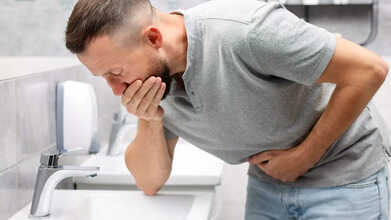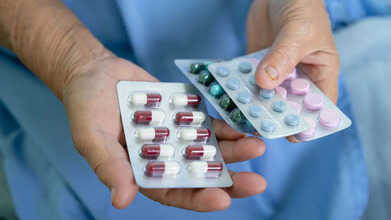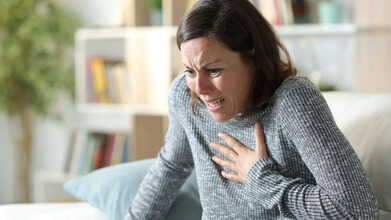- Health Conditions A-Z
- Health & Wellness
- Nutrition
- Fitness
- Health News
- Ayurveda
- Videos
- Medicine A-Z
- Parenting
People In U.S. military's Marine Corps Show Pattern Of Declining Mental Health

Representational Image (Credits: Canva)
The Marine Corps drill instructors (DIs) are undoubtedly the backbone of recruit training, shaping civilians into disciplined individuals for the US Military. However, behind this act of bravery, there lies an alarming mental health crisis. It is the suicide of Logan Sowell in 2021 along with six other among the DIs in the past five years which has raised concerns. It also sheds light on the psychological burden faced by those in such high-pressured roles. Reports also indicate that DIs face disproportionately high levels of suicidal ideation, addiction, and divorce compared to other fellow Marines.
DIs have a very demanding job. It requires them to work 90+ hours weeks, and they run on minimal sleep while maintaining extreme discipline. Their job demands physical endurance and unwavering authority, leaving little room for vulnerability. The pressure to be perfect and the fear of disciplinary action create a suffocating environment where mental health concerns are often ignored. Many, like Angel Acosta III, faced disciplinary action that compounded their stress, making them feel trapped in a downward spiral.
Help and Stigma
Despite the acknowledgment, there is still a lot of stigma that surrounds mental health, especially when it is about those in such harsh services. Accessing mental health services thus remain a challenge for DIs. There is also a lingering fear that asking for help will harm their career or would be seen as a sign of weakness/ In fact, The Washington Post reports that a former DI recalled how colleagues distanced themselves after he admitted needing support, reinforcing the toxic belief that seeking help is sign of weakness.
The Consequences
Without the help that they need, many instructors have turned to alcohol or other substances to cope. This pattern has been noted and it worsens the mental health conditions. Chronic sleep deprivation further exacerbates these issues, increasing the risk of suicidal thoughts. The Marine Corps has attempted to enforce work-hour limitations, but enforcement remains unclear, and many still suffer from the effects of prolonged stress and exhaustion.
Marine Corps is not just the only military sector where such a pattern is seen. Earlier in January, year Matthew Livelsberger, who was a Special Forces soldier also died by suicide. He served in the wartime service in Afghanistan died by a "self-inflicted gunshot" on New Year's Day.
Mental health issues, are often unnoticed, because these are the invisible wounds, which do not have any external signs. Though, mental health issues could be seen in the way the person behaves, however, more often, than not, these are ignored or just termed as "overreacting".
These invisible wounds can also hinder one's ability to regulate their behavior, could also lead to substance abuse, insomnia, and other serious issues. Experts believe, such issues, when unseen and unnoticed can lead to steps like suicide. Recent laws and Pentagon programs have also emphasized screening and self-reporting for such injuries, however, experts and critics doubt if the stigma could be broken and action could be taken?
What Could Be Done Instead?
There are many wellness resources available for the Marine Corps, however the accessibility and effectiveness remain key concerns. There is an urgent need for mental health screenings throughout an instructor’s tenure—not just before training begins. Additionally, reducing stigma, improving work-life balance, and ensuring confidential and immediate access to therapy could prevent further tragedies.
The deaths of these instructors highlight the urgent need for cultural and systemic change within the Marine Corps. Without prioritizing mental well-being, the institution risks losing more of its finest to a battle fought not on the field, but within their own minds.
Winter Vomiting Disease On The Rise In The US: How To Disinfect After Norovirus

Credits: Canva
Norovirus, often called the “stomach flu” or “winter vomiting illness,” is currently circulating in California and across the United States. Health experts say proper cleaning and disinfecting can slow its spread. These precautions matter because norovirus is extremely contagious and there is no specific treatment for it, according to the Centers for Disease Control and Prevention.
Between August 1 and November 13, health officials recorded 153 norovirus outbreaks across 14 states. The CDC defines an outbreak as two or more similar illnesses linked to suspected or lab-confirmed norovirus cases. Although California is not among the states reporting outbreaks, CDC data shows a noticeable rise in positive norovirus tests throughout November across the western US.
What Is Norovirus?
Norovirus is described as a “highly contagious” virus that causes vomiting, diarrhea, and stomach cramps, according to the California Department of Public Health. It leads to acute gastroenteritis, which means inflammation of the stomach or intestines, and affects people of all ages, the CDC said.
Despite its nickname, norovirus has nothing to do with influenza. The flu is caused by the influenza virus, not norovirus, the agency clarified.
Winter Vomiting Disease: How Does The Stomach Bug Spread?
Norovirus spreads easily from person to person, especially while someone is actively sick, according to the California Department of Public Health. Symptoms usually last one to three days, but a person can still spread the virus for up to two days after they start feeling better.
The virus is present in vomit and stool and can spray into the air or settle on nearby surfaces. It can survive for weeks on uncleaned items such as countertops, phones, and doorknobs, the department said.
“You can get sick after touching or caring for someone who is sick, or after touching or eating something that is contaminated,” the department noted.
Norovirus spreads quickly in crowded or enclosed settings, including schools, child care facilities, hospitals, nursing homes, jails, and cruise ships.
According to state and federal health officials, the most common ways people catch norovirus include:
- Touching, caring for, or sharing food with someone who has norovirus
- Eating or drinking contaminated food or beverages, including undercooked shellfish like oysters
- Touching a contaminated surface and then touching your mouth before washing your hands
- Sharing a toilet or bathroom with someone who is sick
- Swallowing contaminated water, including water from swimming pools or recreational areas
- Cleaning up vomit or diarrhea without protective gear, such as gloves or a face mask
Do You Need To Disinfect After Norovirus?
“If you or someone in your household has norovirus, it’s important to clean and disinfect areas where vomiting or diarrhea occurred,” the California Department of Public Health advised. Cleaning with soap and water removes germs, while disinfecting kills those that remain.
You can use commercial disinfectants, but it’s important to read the label and make sure norovirus is listed among the germs it targets. You can also check the Environmental Protection Agency’s registration number and confirm it appears on the EPA’s List G, which includes products proven effective against norovirus.
Another option is making a bleach solution at home. The US Department of Agriculture recommends mixing 5 to 25 tablespoons of household bleach with one gallon of water. This solution should be used only on hard or nonporous surfaces and applied with a spray bottle or disposable mop, sponge, or paper towel. Let it sit for about five minutes before wiping it away.
The USDA also advises paying close attention to frequently touched items such as doorknobs, handles, and remote controls. Many disinfectant wipes do not fully kill norovirus, the agency warned.
How To Disinfect After Norovirus?
The CDC recommends wearing rubber or disposable gloves while cleaning. Use paper towels to wipe the affected area completely, then place the towels in a plastic trash bag. The California Department of Public Health also suggests wearing a face mask.
After disinfecting, clean the area again with soap and water, the CDC said. Keep in mind that vomit can aerosolize the virus, meaning surfaces several feet away may also be contaminated, according to the USDA.
Once you’re done, throw away the gloves and mask, then take out the trash, the California Department of Public Health advised.
Taking Statins Or Amlodipine? UK Health Experts Issue New Medication Warning

Credits: Canva
Millions of people across the UK who take certain everyday medicines are being warned by the NHS to steer clear of a specific fruit. Health officials say combining this fruit or its juice with some medications can trigger serious reactions and unexpected side effects. The advice applies to patients prescribed some of the most commonly used drugs in the country, including certain statins, amlodipine, and medicines for anxiety. Statins, in particular, are widely prescribed to help reduce levels of “bad” LDL cholesterol in the blood.
Why Statins Are Commonly Prescribed?
Statins work by limiting how much cholesterol the liver makes. This helps slow down the build-up of fatty deposits inside the arteries, which in turn lowers the risk of heart attacks and strokes. Doctors prescribe statins both to manage high cholesterol and to prevent future heart-related problems. For most people, they are taken daily as tablets and are often part of long-term treatment.
What Does Amlodipine Do?
Amlodipine, commonly sold under the brand name Istin, belongs to a group of medicines known as calcium channel blockers. It is mainly used to treat high blood pressure. For people with hypertension, amlodipine can reduce strain on the heart and lower the risk of serious complications such as heart disease, heart attacks, and strokes.
NHS Warning On Statins Or Amlodipine
Patients taking certain forms of amlodipine, particularly calcium channel blockers, are advised not to consume grapefruit. The NHS website clearly states: “Do not take amlodipine with grapefruit juice.”
The reason lies in how grapefruit affects the body. It interferes with enzymes and transport proteins in the gut, such as CYP3A4 and P-gp, which normally help break down medicines and control how much enters the bloodstream. When these processes are blocked, higher-than-intended amounts of the drug can build up in the body, increasing the risk of side effects.
What Patients Should Keep In Mind
Not every medicine reacts the same way to grapefruit juice, which is why doctors advise checking before making changes. Always speak to your GP or pharmacist, read the information leaflet that comes with your medicine, and look out for any warnings related to grapefruit.
It is also important to understand that simply spacing the fruit and the medicine apart is not enough. In most cases, grapefruit should be avoided entirely for as long as you are on the medication, unless your doctor says otherwise. Patients are also encouraged to be cautious with other citrus fruits, such as Seville oranges, pomelos, and limes, as they can have similar effects on how medicines work.
What To Do If You’ve Already Consumed It?
If you have eaten grapefruit or had its juice while taking statins, amlodipine, or anti-anxiety medication, there is no need to panic. In many cases, a single exposure does not lead to serious harm, but it is important to stay alert. Pay attention to how your body feels over the next day or two, especially if you notice symptoms such as dizziness, muscle pain, unusual tiredness, nausea, flushing, or a sudden drop in blood pressure.
Do not stop taking your medication on your own. Skipping doses or stopping treatment abruptly can be risky, particularly for heart and blood pressure medicines. Instead, make a note of what you consumed and when, and contact your GP or pharmacist for advice. They can tell you whether any action is needed based on the specific drug, dose, and your overall health.
Holiday Heart Syndrome Explained: Causes, Symptoms, And How To Stay Safe

Credits: Canva
During the festive months, overindulgence in celebrations can trigger holiday heart syndrome (HHS), a potentially serious yet largely preventable set of heart-related symptoms that tend to rise during this time of year. Most people recover within a day, but HHS can occasionally lead to stroke, heart attack, or other serious complications, according to the Cleveland Clinic. As the holiday season approaches, let’s explore what holiday heart syndrome is, its symptoms, and how to prevent it.
What Is Holiday Heart Syndrome?
First identified by a US physician in 1978, holiday heart syndrome describes irregular heartbeats that occur after binge drinking during the festive season. Research from the University of South Australia shows that alcohol consumption increases by 70 per cent in December compared to other months, while iSelect data predicts Australians may consume around 58 million standard drinks per day during the month. With numbers like these, some caution is warranted.
Atrial fibrillation (AFib) is the specific irregular heartbeat seen in HHS. It occurs when the heart’s upper chambers contract or quiver in a chaotic pattern, which can cause blood to pool in the atrium and form clots. If these clots enter the bloodstream, they can travel to the brain and trigger a stroke.
What Are the Symptoms of Holiday Heart?
Symptoms can include fatigue, dizziness, shortness of breath, anxiety, weakness, confusion, sweating, faintness, unusual tiredness during exercise, rapid or irregular heartbeat, and sensations like fluttering, thumping, pressure, or chest pain.
Dr Mariann R. Piano, Nancy and Hilliard Travis Professor of Nursing at Vanderbilt University School of Nursing, warns, “The scary thing is that people may not notice any symptoms, which makes it a particularly dangerous arrhythmia.”
How Can Drinking Lead to AFib?
Researchers are still investigating exactly how alcohol triggers AFib and how much intake increases the risk. A 2020 study found that people who usually drank at least 10 alcoholic beverages a week lowered their risk of holiday heart syndrome by reducing alcohol consumption. Another study confirmed that eliminating alcohol significantly decreases the chances of developing AFib.
How To Try to Avoid Holiday Heart Syndrome
The Australian Alcohol Guidelines recommend that healthy adults limit alcohol to no more than 10 standard drinks per week to reduce risk.
Experts like Kistler suggest that people with existing heart arrhythmias either abstain or stick to “up to three standard drinks a week.” Drinking mindfully, reducing overall consumption, and staying well hydrated can also help protect your heart.
Tips To Keep Your Heart Healthy During Holidays
Here are some practical ways to protect your heart during the festive season:- Eat smaller, balanced meals and avoid heavy late-night feasts.
- Limit alcohol intake and stay hydrated.
- Continue regular medications without interruption.
- Stay warm and avoid sudden exposure to cold temperatures.
- Maintain light physical activity and avoid strenuous exertion in the early morning.
- Manage stress by taking breaks, sleeping adequately, and avoiding overexertion during travel or celebrations.
- Seek medical help immediately if you experience chest discomfort, unusual fatigue, breathlessness, or palpitations.
© 2024 Bennett, Coleman & Company Limited

